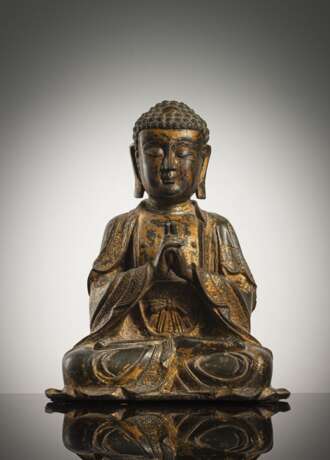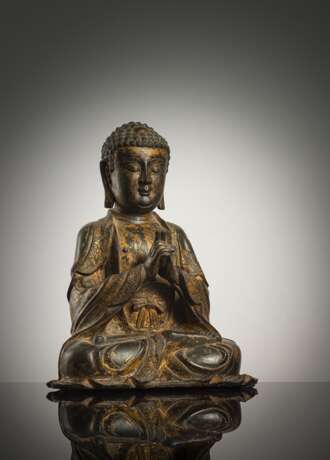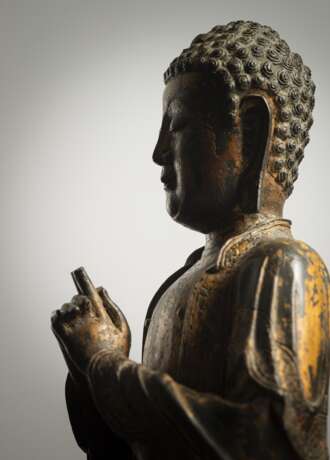ID 1215733
Lot 331 | Bronze des Buddha Shakyamuni mit Resten von Vergoldung
Estimate value
€ 5 000 – 8 000
H. 32,5 cm
Er sitzt in der dhyanasana-Haltung und blickt nach unten auf seine nach oben gehaltenen Hände, die sich mit erhobenen und sich berührenden Zeigefingern überlappen. Die Bänder seines Untergewandes und seines Obergewandes sind ebenfalls sorgfältig mit zusammengesetzten Blütenköpfen und gewundenen Blättern ziseliert; die unteren Ränder der Draperie bilden eine Basis mit dreieckigem Querschnitt. Sein Gesicht zeigt einen heiteren Ausdruck. Sein gelocktes Haar steht in einer niedrigen ushnisha und ist mit der ratna versehen.
Alte deutsche Adelssammlung, zusammengetragen in China vor 1930
Die Ikonographie der gefalteten Hände mit erhobenen Zeigefingern wurde auf verschiedene Weise identifiziert: erstens als die Abhiseka-Mudra (guanding yin) von Vairocana, dem Buddha, der den Dharmakaya (oder Dharmakörper) verkörpert, wie er im Brahma-Net-Sutra (Fanwang jing) und im Avatamsaka-Sutra (Huayan jing) beschrieben wird. Im Einklang mit dieser Identifizierung als Vairocana stehen die beiden Räder des Gesetzes, die auf den Fußsohlen dieses Loses eingraviert sind. In der buddhistischen Skulptur der Ming-Zeit wird Vairocana oft mit einer fünfzackigen Krone dargestellt: siehe zum Beispiel die große gekrönte Goldbronzefigur aus dem 16. Vairocana, verkauft bei Christie's, Hongkong, Auktion 2862, 1. Juni 2011, Lot 3770. Die Geste der gefalteten Hände wurde auch als uttarabodhi mudra (zuigao qidi yin) identifiziert, die traditionell mit dem historischen Sakyamuni Buddha in Verbindung gebracht wird: siehe das Beispiel aus der Yuan-Dynastie, eine vergoldete Bronzefigur des Buddha mit gewölbter usnisa und zwei Urna, sitzend in dhyanasana, identifiziert als Sakyamuni als Asket bei Sotheby's, Hongkong, 8. April 2011, Lot 3045 - Abriebe der Vergoldung
| Address of auction |
Nagel Auktionen GmbH Neckarstrasse 189 - 191 70190 Stuttgart Germany | ||||||||||||||
|---|---|---|---|---|---|---|---|---|---|---|---|---|---|---|---|
| Preview | |||||||||||||||
| Phone | +49 (0)711 649 690 | ||||||||||||||
| Fax | +49 (0)711 649 69696 | ||||||||||||||
| Buyer Premium | 29,5% | ||||||||||||||
| Conditions of purchase | Conditions of purchase | ||||||||||||||
| Business hours | Business hours
|






